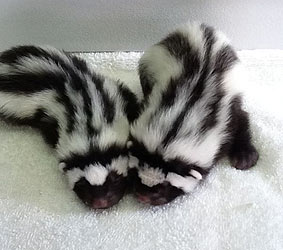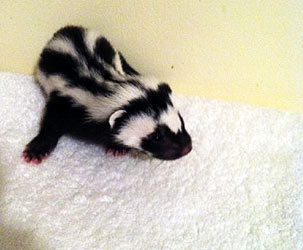Polecat For Sale


Despite their name, polecats are more closely related to dogs, than to cats. The term polecat is applied to several species of European weasel-like mammals and, in the United States, it is also used for the black-footed ferret. Polecats typically have long, black fur that shines with a bluish gleam in the sunlight. They have white marking on their faces and ears that resemble bandit-like masks. Male and female polecats are similar in appearance but the males are a bit longer, about 22 inches long to the female's 19-inches.
No Polecat currently listed for placement
Pet Polecat
Polecat Diet
Polecats eat an entirely carnivorous diet. In the wild, they hunt at night for frogs, snakes, birds, insects, fish, and eels. In captivity, polecats can be fed commercially-made ferret food with a supply of fresh meat, such as frozen feeder mice or grasshoppers.
Polecat Habitat
Polecats are found in lower altitudes and prefer wooded areas and farmland located near rivers. They often make their dens along river banks or exposed tree roots along embankments. In captivity, polecats are often allowed free range of the pet owner's home, but polecat owners should consider putting the animal in a cage when no one is home for the safety of the animal and to protect the house from damage. The cage can be one designed for ferrets, ideally one that is a minimum of two feet long, two feet deep, and a foot and a half tall. A much larger cage will be needed for two animals. The cage should have multiple levels and enclosed sleeping areas.
Polecat Enrichment
Polecats are nocturnal and love to explore their surrounding all night long. If pet owners allow their polecats to have total access to their homes, they should take care to thoroughly pet-proof the loving areas. Polecats are curious and clever…they can open cupboard doors, squeeze into heating ducts, and burrow their way into a box spring. Providing them with play things in their cage may lessen the chances of them destroying household items or injuring themselves. A hammock or swing will keep them occupied. Boxes filled with soft material will give them a safe place to burrow.
Breeding Polecats
Polecats mate once a year, in May or June, and will produce a litter of five to eight kits about 40 to 42 days later. The babies are completely weaned after about four weeks and reach adulthood at three months of age. Polecats have a life expectancy of approximately five years.







Comments